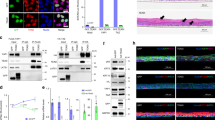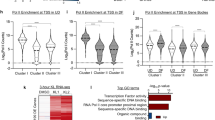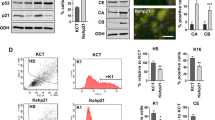Abstract
The p53 paralogues p73, p63 and their respective truncated isoforms have been shown to be critical regulators of developmental and differentiation processes. Indeed, both p73- and p63-deficient mice exhibit severe developmental defects. Here, we show that S100A2 gene, whose transcript and protein are induced during keratinocyte differentiation of HaCaT cells, is a direct transcriptional target of p73β and ΔNp63α and is required for proper keratinocyte differentiation. Transactivation assays reveal that p73β and ΔNp63α exert opposite transcriptional effects on S100A2 gene. While ΔNp63α is found in vivo onto S100A2 regulatory regions predominantly in proliferating cells, p73β is recruited in differentiating cells. Silencing of p73 impairs the induction of S100A2 during the differentiation of HaCaT cells. Moreover, silencing of p73 or S100A2 impairs the proper expression of keratinocyte differentiation markers. Of note, p53 family members do not trigger S100A2 gene expression in response to apoptotic doses of cisplatin and doxorubicin.
This is a preview of subscription content, access via your institution
Access options
Subscribe to this journal
Receive 50 print issues and online access
$259.00 per year
only $5.18 per issue
Buy this article
- Purchase on Springer Link
- Instant access to full article PDF
Prices may be subject to local taxes which are calculated during checkout






Similar content being viewed by others
References
Attardi LD, Reczek EE, Cosmas C, Demicco EG, McCurrach ME, Lowe SW et al. (2000). Genes Dev 14: 704–718.
Bamberger C, Pollet D, Schmale H . (2002). J Investl Dermatol 118: 133–138.
Blandino G, Dobbelstein M . (2004). Cell Cycle 3: 886–894.
Bourdon J, Fernandes K, Murray-Kmijewski F, Liu G, Diot A, Xirodimas DP et al. (2005). Genes Dev 19: 2122–2137.
Brummelkamp TR, Bernards R, Agami R . (2002). Science 296: 550–553.
Costanzo A, Merlo P, Pediconi N, Fulco M, Sartorelli V, Cole PA et al. (2002). Mol Cell 9: 175–186.
Dale BA, Presland RB, Lewis SP, Underwood RA, Fleckman P . (1997). J Invest Dermatol 108: 179–187.
Dazard JE, Gal H, Amariglio N, Rechavi G, Domany E, Givol D . (2003). Oncogene 22: 2993–3006.
De Laurenzi V, Catani MV, Terrinoni A, Corazzari M, Melino G, Costanzo A et al. (1999). Cell Death Differ 6: 389–390.
De Laurenzi V, Costanzo A, Barcaroli D, Terrinoni A, Falco M, Annichiarico-Petruzzelli M et al. (1998). J Exp Med 188: 1763–1768.
De Laurenzi V, Raschellà G, Barcaroli D, Annichiarico-Petruzzelli M, Ranalli M, Catani MV et al. (2000). J Biol Chem 275: 15226–15231.
Donato R . (2003). Microsc Res Tech 60: 540–551.
Eckert RL, Broome AM, Ruse M, Robinson N, Ryan D, Lee KJ . (2004). Invest Dermatol 123: 23–33.
el-Deiry WS, Tokino T, Velculescu VE, Levy DB, Parsons R, Trent JM et al. (1993). Cell 75: 817–825.
Fernandez-Fernandez MR, Veprintsev DB, Fersht AR . (2005). Proc Natl Acad Sci USA 102: 4735–4740.
Fontemaggi G, Gurtner A, Strano S, Higashi Y, Sacchi A, Piaggio G et al. (2001). Mol Cell Biol 21: 8461–8470.
Fontemaggi G, Kela I, Amariglio N, Rechavi G, Krishnamurthy J, Strano S et al. (2002). J Biol Chem 277: 43359–43368.
Gupta S, Hussain T, MacLennan GT, Fu P, Patel J, Mukhtar H . (2003). J Clin Oncol 21: 106–112.
Heierhorst J, Kobe B, Feil SC, Parker MW, Benian GM, Weiss KR et al. (1996). Nature 380: 636–639.
Hibi K, Fujitake S, Takase T, Kodera Y, Ito K, Akiyama S et al. (2003). Clin Cancer Res 9: 4282–4285.
Ihrie RA, Marques MR, Nguyen BT, Horner JS, Papazoglu C, Bronson RT et al. (2005). Cell 120: 843–856.
Jost CA, Marin MC, Kaelin Jr WG . (1997). Nature 389: 191–194.
Kaghad M, Bonnet H, Yang A, Creancier L, Biscan JC, Valent A et al. (1997). Cell 90: 809–819.
Maelandsmo GM, Florenes VA, Mellingsaeter T, Hovig E, Kerbel RS, Fodstad O . (1997). Int J Cancer 74: 464–469.
Mantovani F, Piazza S, Gostissa M, Strano S, Zacchi P, Mantovani R et al. (2004). Mol Cell 14: 625–636.
Mills AA, Zheng B, Wang XJ, Vogel H, Roop DR, Bradley A . (1999). Nature 398: 708–713.
Mischke D, Korge BP, Marenholz I, Volz A, Ziegler A . (1996). J Invest Dermatol 106: 989–992.
Pozniak CD, Radinovic S, Yang A, McKeon F, Kaplan DR, Miller FD . (2000). Science 289: 304–306.
Signoretti S, Waltregny D, Dilks J, Isaac B, Lin D, Garraway L et al. (2000). Am J Pathol 157: 1769–1775.
Steinert PM, Marekov LN . (1997). J Biol Chem 272: 2021–2030.
Strano S, Monti O, Pediconi N, Baccarini A, Fontemaggi G, Lapi E et al. (2005). Mol Cell 18: 447–459.
Strano S, Munarriz E, Rossi M, Castagnoli L, Shaul Y, Sacchi A et al. (2001). J Biol Chem 276: 15164–15173.
Strano S, Munarriz E, Rossi M, Cristofanelli B, Shaul Y, Castagnoli L et al. (2000). J Biol Chem 275: 29503–29512.
Tan M, Heizmann CW, Guan K, Schafer BW, Sun Y . (1999). FEBS Lett 445: 265–268.
Vellucci VF, Germino FJ, Reiss M . (1995). Gene 166: 213–220.
Yang A, Kaghad M, Caput D, McKeon F . (2002). Trends Genet 18: 90–95.
Yang A, Kaghad M, Wang Y, Gillett E, Fleming MD, Dostch V et al. (1998). Mol Cell 2: 305–316.
Yang A, Schweitzer R, Sun D, Kaghad M, Walker N, Bronson RT et al. (1999). Nature 398: 714–718.
Yang A, Walker N, Bronson R, Kaghad M, Oosterwegel M, Bonnin J et al. (2000). Nature 404: 99–103.
Zaika AI, Kovalev S, Marchenko ND, Moll UM . (1999). Cancer Res 59: 3257–3263.
Acknowledgements
We thank Dr R Agami and Dr A Costanzo for plasmids, antibodies and helpful suggestions. This work was supported by Telethon (no.GGP030358), Italian Association for Cancer Research to GB and SS (AIRC); Ministero della Salute; MIUR-FIRB Italy; Italia-USA and EC FP6 funding (Contract 503576). This publication reflects the authors' views and not necessarily those of the European Community. The EC is not liable for any use that may be made of the information contained herein.
Author information
Authors and Affiliations
Corresponding author
Rights and permissions
About this article
Cite this article
Lapi, E., Iovino, A., Fontemaggi, G. et al. S100A2 gene is a direct transcriptional target of p53 homologues during keratinocyte differentiation. Oncogene 25, 3628–3637 (2006). https://doi.org/10.1038/sj.onc.1209401
Received:
Revised:
Accepted:
Published:
Issue Date:
DOI: https://doi.org/10.1038/sj.onc.1209401
Keywords
This article is cited by
-
p63 is a cereblon substrate involved in thalidomide teratogenicity
Nature Chemical Biology (2019)
-
ΔNp63α expression induces loss of cell adhesion in triple-negative breast cancer cells
BMC Cancer (2016)
-
Tyr99 phosphorylation determines the regulatory milieu of tumor suppressor p73
Oncogene (2016)
-
S100A2 is a BRCA1/p63 coregulated tumour suppressor gene with roles in the regulation of mutant p53 stability
Cell Death & Disease (2014)
-
Joining S100 proteins and migration: for better or for worse, in sickness and in health
Cellular and Molecular Life Sciences (2014)



